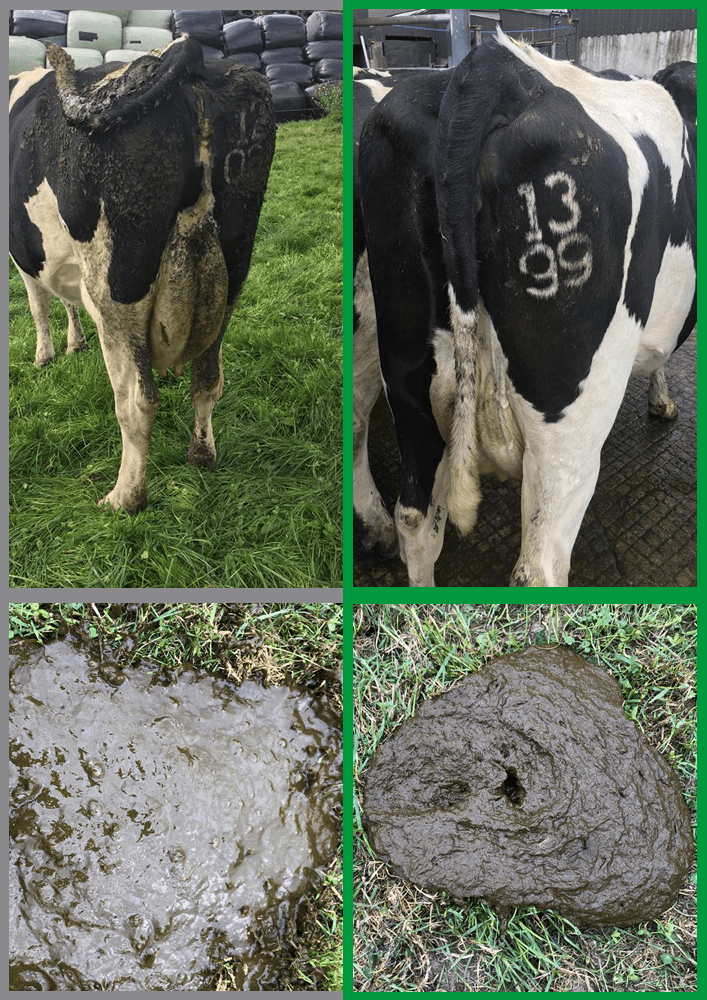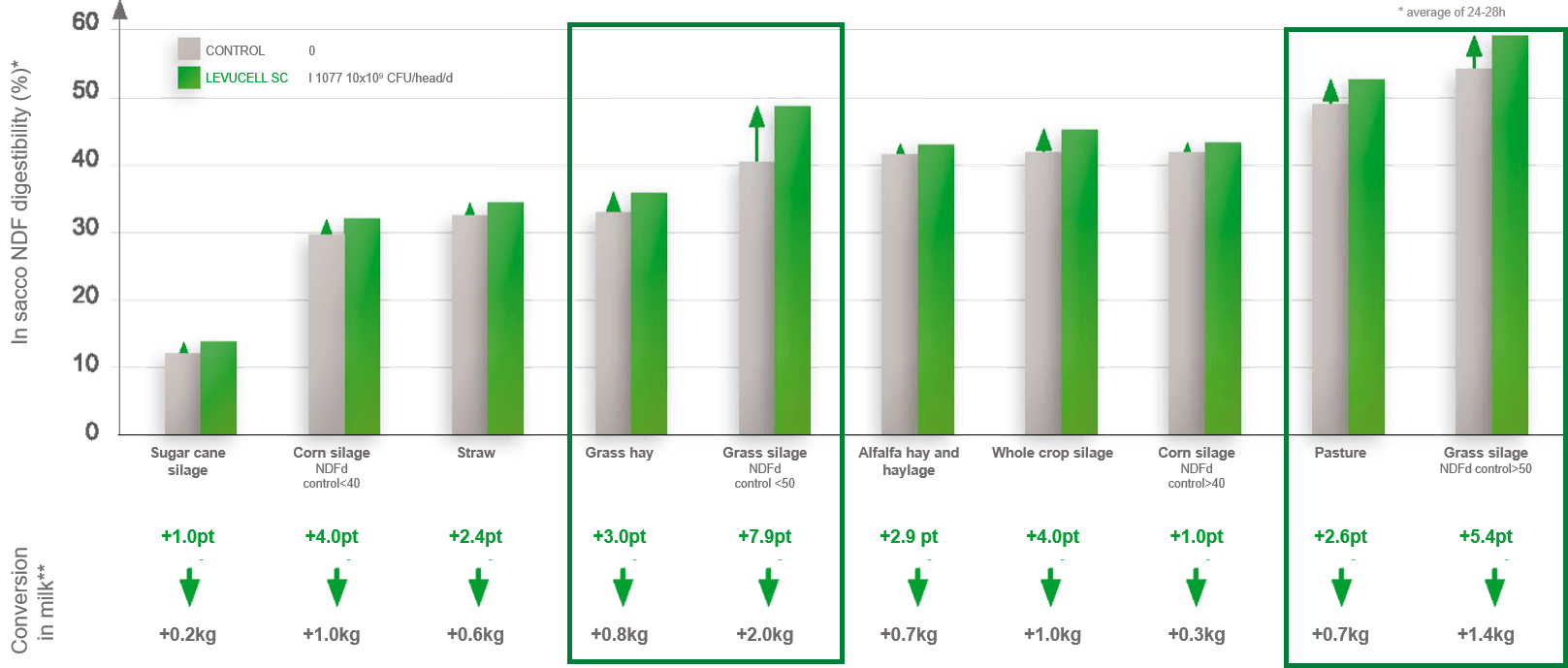Blog | Reading Time 7 minutes
How does live yeast benefit grazing cows?
More than 50% of farming systems worldwide use grass-based diets. Such diets offer both economic and environmental benefits: lower feed costs and no feed-food competition. When comes the end of the winter season, the transition from indoor diets to lush grass must be well managed to avoid important stresses for the rumen and its workers, the microbiota (Waters et al. 2020)! Such stress can be translated into poor performance and welfare, including higher risks of Sub Acute Ruminal Acidosis (SARA).
Turnout to grass is a challenging time for the cows, and the rumen-specific live yeast Saccharomyces cerevisiae CNCM I-1077 can help preserve rumen function with positive financial outcomes.
Lush grass: a challenge for the rumen
Farmers know that when cows are grazing lush grass they go ‘a bit loose,’ which is a real inconvenience at milking time. Loose manure can also indicate poor rumen digestion due to SARA, particularly if gas bubbles and undigested fibers are visible. The financial implications of compromised rumen function are significant. Milk quality can be reduced, and cows will not milk to their full potential.
How can this be explained?
“Any change in dietary conditions affects rumen microbiota composition and activity. Indeed, the rumen microbiota is the one which enables the ruminant animal to digest most of its diet components, in particular forages, and, at turnout to grass, animals are shifted from the winter diet (composed by starch concentrate and corn or grass silage most of the time) to lush grass with high fermentable sugars and readily digestible cellulosic material, which increases the risk of SARA, as well as highly soluble nitrogen diet. Thus, during the first weeks of the grazing period, rumen microbiota may be quite unstable with increased challenges for rumen health,” explains Dr. Frédérique Chaucheyras-Durand, Research Manager at Lallemand Animal Nutrition.
Research has shown that fibrolytic and proteolytic populations increase in the rumen during the transition to a pasture diet (Belanche et al., 2019). “As young grass is rich in soluble sugars, especially fructans, a strong increase in lactate-producing bacteria, such as Streptococcus has been measured, which puts the animal at risk for rumen acidosis and bloat,” added Chaucheyras-Durand.
Preserving the rumen…
The live yeast strain Saccharomyces cerevisiae CNCM I-1077 (LEVUCELL SC) is described as a rumen modifier. It has been specifically selected and documented for its beneficial effects in the rumen, leading to the stabilization of rumen pH and the stimulation of growth and activity of fibrolytic microflora (Figure 1). At turnout to grass, in particular, trials have shown a significant increase in average rumen pH and significant decreases in time spent with a rumen pH below 6, which is considered an indicator of SARA.
Figure 1: Schematic representation of the live yeast Saccharomyces cerevisiae CNCM I-1077 and its modes of action in the rumen (backed up by more than 100 scientific publications).

Figure 2: Observation of cow cleanliness and manure consistency during grazing: left control cow, right live yeast supplemented cows (LEVUCELL SC) (Lallemand commercial trial, Ireland 2019).
Of course, not all cows are equipped with rumen pH monitors! At the farm level, manure consistency is a reliable indicator of rumen function. A commercial trial conducted in Ireland during the 2019 grazing season measured this indicator. Starting in May 2019, 27 Holstein cows received the live yeast while 28 received no additional supplementation to their 5kgs of 14% cereal-based diet. The farmers observed a difference in manure quality with the unsupplemented cows being much looser. The supplemented cows were considerably cleaner throughout the trial (+34% of the cows were cleaner), with better manure consistency: +38% improvement in manure consistency (as measured by the Lallemand Rumen Efficiency Investigation (REI) audit tool – see boxed text-) with no foamy manure (figure 2).
The Rumen Efficiency Investigation (REI) audit
The REI audit is a holistic approach based on the assessment of a set of measurable indicators at farm level. There are nine indicators in total, selected by integrating bibliography reviews, practical dairy farms surveys, and international expert views, and validated in the field. These indicators are linked to dairy performance data, animal observations, manure observation and environmental conditions (THI). This integrated method is an interesting decision-making tool as it enables the farm team and nutritionist to get a snapshot of a dairy herd status at different time points and to evaluate the impact of nutrition or herd management changes.
…for long-term outcomes
If sugar-rich, lush grass represents a challenge for the rumen, it is also a source of accessible energy (low NDF). As it matures, plant material exhibits lower levels of rapidly fermentable sugars and proteins, and higher levels of NDF (fiber). NDF degradability can represent a limiting factor for milk energy and nutrient extraction. This is why increased supply of concentrate is usually recommended as plants mature to fulfill the milk energy needs. This will increase the risk of rumen challenges — and also the feedstuff bill for the farmer.
It is well documented that the activity of S. cerevisiae I-1077 in the rumen enhances the degradation of fibers from the diet (Chaucheyras-Durand et al., 2016). This leads to higher feed efficiency or improved income-over-feed cost when the dairy diet is supplemented. The fiber degradation enhancement effect depends on the forage used. NDF degradability is improved by 2.6 to 7.9 units in pasture, grass hay, or grass silages samples (figure 3).

Figure 3: Effect of live yeast on NDF degradability for various forages (from Ding et al., 2014, Sousa et al., 2018, Guedes et al.,2010).
Thus, when used throughout the grazing period, the yeast supplement helps secure the rumen pH and also the milk revenue. In the Irish trial, the cows supplemented with the live yeast produced on average 0.5 L more milk per day with significantly higher fats and proteins than the non-supplemented cows based on the milking robot data. The farmers reported a 6:1 return on investment thanks to the additional milk solids versus the cost of the yeast (figure 4). The average increase in dairy production shown among previous trials has been calculated to 1.6 kg/day and up to 2.3 kg during the transition from TMR to grazing.
| Milk performance | Control | S. c. I-1077 |
|---|---|---|
| Milk production (kg/hd/d) | 28.70 | 29.22 (+0.52)** |
| Milk protein (%) | 3.39 | 3.43 *** |
| Milk fat (%) | 3.97 | 4.14 *** |
| 4% Fat corrected milk (kg/hd/d) | 27.70 | 28.84 (+1.14)*** |
Figure 4: Effect of live yeast supplementation on grazing cows performance (**p<0.001*** p<0.000 ; Lallemand commercial trial, Ireland 2019).
In conclusion, grazing represents two levels of challenges for the rumen: a welfare issue at turnout to grass due to increased SARA risks and a performance challenge later on due to NDF quality. Thanks to its benefits both on rumen pH and fiber degradation, live yeast is a winning approach on both levels. To optimize its efficacy, it is recommended to start supplementing the cows a few weeks before turnout to help prepare the rumen for the transition.
Not all products are available in all markets nor associated claims allowed in all regions.
Published Mar 4, 2021 | Updated Dec 5, 2023
Related articles
Need specific information?
Talk to an expert